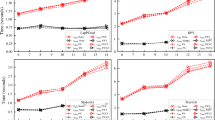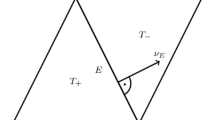We provide all necessary theoretical statements concerning the hydrodynamical double layer potential, which enable the application of an adaptive version of the fast multipole method of Greengard and Rokhlin to the interior Dirichlet problem of the Stokes system and present numerical experiments confirming these theoretical statements. Bibliography: 26 titles. Illustrations: 3 figures.
Similar content being viewed by others
References
J. Carrier, L. Greengard, and V. Rokhlin, “A fast adaptive multipole algorithm for particle simulations,” SIAM J. Sci. Statist. Comput. 9, No. 4, 669–686 (1988).
F. Ethridge and L. Greengard, “A new fast multipole accelerated Poisson solver in two dimensions,” SIAM J. Sci. Comput. 23, No. 3, 741–760 (2001).
L. Greengard and V. Rokhlin, “The rapid evaluation of potential fields in three dimensions,” In: Vortex Methods, 121–141, Lect. Notes Math. 1360, Springer, Berlin (1988).
L. Greengard and V. Rokhlin, “A new version of the fast multipole method for the Laplace equation in three dimensions,” Acta Numerica 6, 229 (1997).
R. Coifman, V. Rokhlin, and S. Wandzur, “The fast multipole method for the wave equation,” A pedestrian prescription, IEEE Antennas and Propagation Magazine (1993).
M. Fischer, U. Gauger, and L. Gaul, “A multipole Galerkin boundary element method for acoustics,” Eng. Anal. Bound. Elem. 28, 155–162 (2004).
L. Greengard, V. Rokhlin, et al. “Accelerating fast multipole methods for the Helmholz equation at low frequencies,” Comp. Sci. Eng. 5, 32–38 (1998).
L. Greengard, V. Rokhlin, et al. “A wideband fast multipole method for the Helmholz equation in three dimensions,” J. Comp. Phys. 216, 300–325 (2007).
E. Darve, “The fast multipole method I: error analysis and asymptotic complexity,” SIAM J. Numer. Anal. 38 , 98–128 (2000).
E. Darve, “The fast multipole method: numerical implementation,” J. Comp. Phys. 160 , 195–240 (2000).
J.-M. Song and W. C. Chew, “Multilevel fast multipole algorithm for electromagnetic scattering by large complex objects,” IEEE Trans. Antennas Propag. textbf45(10) 1488–1496 (1997).
G. Of, “A fast multipole boundary element method for the symmetric boundary integral formulation in linear elastostatics,” Comp. Fluid Solid Mech. 540–543 (2003).
G. Of, O. Steinbach, and W. Wendland, “Application of a fast multipole Galerkin boundary element method in linear elastostatics,” Comput. Visual. Sci. 8, 201–209 (2005).
Y. Zhenhan, W. Haitao, W. Pengbo, and L. Ting, Some Applications of Fast Multipole Boundary Element Method, Preprint, Tsinghua University, Beijing (2004).
G. C. Hsiao, “Integral representation of solutions for two-dimensional viscous flow problems,” Integral Equ. Operator Theory 5, 533–547 (1982).
G. C. Hsiao and R. Kress, “On an integral equation for the two-dimensional exterior Stokes problem,” Appl. Numer. Math. 1, No. 1, 77–93 (1985).
M. Kohr and W. Wendland, “Variational boundary integral equations for the Stokes system,” Appl. Anal. 85, No. 1,, 1343–1372 (2006).
O. A. Ladyzhenskaya, The Mathematical Theory of Viscous Incompressible Flow, Gordon and Breach, New York (1969).
F. K. G. Odquist, “Über die Randwertaufgaben in der Hydrodynamik zäher Flüssigkeiten,” Math. Z. 32, 329–375 (1930).
W. Varnhorn, The Stokes Equations, Akademie-Verlag, Berlin (1994).
L. Greengard, M. C. Kropinski, and A. Mayo, “Integral equation methods for Stokes flow and isotropic elasticity in the plane,” J. Comp. Phys. 125, 403–414 (1996).
J. Gomez B. Peault et al. “A multipole direct and indirect BEM for 2D cavity flow at low Reynolds number,” Eng. Anal. Boundary Elem. 19, 17–31 (1997).
B. N. Khoromskij and G. Wittum, Numerical Solution of Elliptic Differential Equations by Reduction to the Interface, Springer, Berlin (2004).
A. N. Popov, “Application of potential theory to the solution of a Linearized System of Navier–Stokes Equations in the two-dimensional case,” In: Proceedings of the Steklov Institute of Mathematics 116, pp. 167–186, Am. Math. Soc., Providence, RI (1973).
L. Greengard and V. Rokhlin, “A fast algorithm for particle simulations,” J. Comp. Phys. 135, 280–292 (1997).
V. Rokhlin, “Rapid solution of integral equations of classical potential theory,” J. Comp. Phys. 60, 187 (1985).
Author information
Authors and Affiliations
Corresponding author
Additional information
Translated from Problems in Mathematical Analysis 60, September 2011, pp. 65–76.
Rights and permissions
About this article
Cite this article
Samrowski, T. Justification of the fast multipole method for the stokes system in the case of the interior diriclet problem. J Math Sci 178, 637–650 (2011). https://doi.org/10.1007/s10958-011-0575-4
Received:
Published:
Issue Date:
DOI: https://doi.org/10.1007/s10958-011-0575-4




